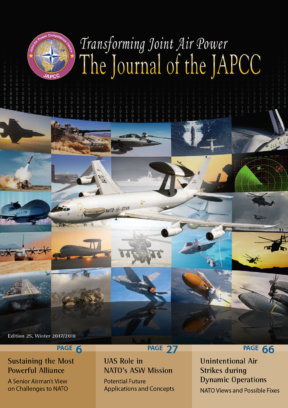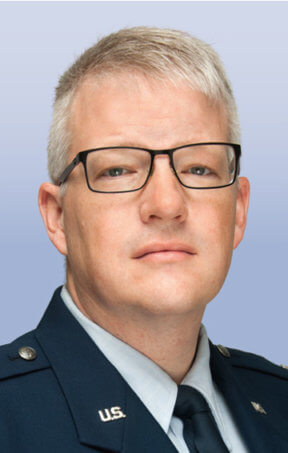The emphasis on air integration is very important to us. We know that we are never going to fight alone – it’s always going to be joint, it’s always going to be combined. Which is why on the combined side it’s a NATO exercise, and on the joint side we want to fight in all domains and practice that integration. That means air, sea and land …
US Navy Vice Admiral Christopher Grady, Commander, Naval Striking and Support Forces NATO (2017)1
Introduction
As current world events shape the future operating environment, NATO must take great care with how it intends to project power. The strongest approach is presenting a united coalition front, demonstrating a strong alliance. Turning this political commitment into action requires the operational ability to work together, or be interoperable. Shrinking national budgets coupled with rising tensions and NATO’s increasing presence in global affairs makes the answer to the interoperability question vital to NATO’s future success.
The term interoperability means different things to different people; is it the ability to operate together, the ability to use the same governing guidance, or the ability to replace one completely with the other? The Concise Oxford English Dictionary 12th Edition (2011) defines interoperable as ‘able to operate in conjunction’2 while NATO offers a more Alliance centric definition: ‘The ability to act together coherently, effectively and efficiently to achieve Allied tactical, operational and strategic objectives.’3 While NATO specifies the term interoperability, it further offers the term military interoperability as ‘the ability of military forces to train, exercise and operate effectively together in the execution of assigned missions and tasks’.4 It is within this framework of military interoperability that possible solutions for the future will be explored.
Each nation, including our own, has its agendas. Every nation, including the US, is going to protect its own defence industry.
Lieutenant General Fredrick ‘Ben’ Hodges, Commander, NATO Land Command (2014)5
The first stumbling block toward greater interoperability is shrinking defence budgets.6
Stumbling Blocks
With defence dollars so hard to come by since 2008, purchasing new equipment for the sole purpose of being interoperable is a difficult proposition.7 This fiscal constraint levied on NATO members must drive innovation and what is commonly referred to ‘out-of-the-box’ thinking, solving the interoperability problem without new procurement. The shrinking budgets have had the added consequences of limiting fleet sizes or aircraft types, cancelling programmes, extending the service life of more expensive systems, and foregoing recapitalization.8 This forces countries to carefully choose what size and type of transport aircraft they purchase, whether they primarily have large strategic aircraft or smaller tactical aircraft. Gone may be the days of large mixed fleets of strategic and tactical aircraft belonging to a single country, replaced instead by pooling and sharing of resources to increase the synergistic effects of NATO members.
Perhaps the biggest driver of how to spend those limited defence budgets is national priorities. As Lieutenant General Hodges stated in 2014, nations are going to protect their own defence industries and ultimately purchase the systems that make the most sense for them at the time. The construct of NATO does not allow for the alliance to force a country to purchase a specific capability let alone a specific piece of hardware; what a country purchases is a national decision aligned with its own priorities. All NATO can do is make a case for a country to purchase something that is in-line with a broader NATO plan.
Way Ahead
It is clear that a top-down approach within NATO will have limited success when it comes to forcing nations to purchase equipment or adopt specific tactics, techniques, and procedures (TTPs). But progress toward increasing interoperability has been and will continue to be furthered through lower-level groups such as those described below. Each of these groups focus on interoperability; however, they each have a different lesson to teach.
A-400M Operational User Group (OUG). The A-400M OUG is a group headed by the European Air Transport Command (EATC) with the goal of increasing interoperability across all the nations wishing to procure the A-400M, even those outside the EATC umbrella. The overall goal is to achieve ‘efficiencies of operation through co-operation, standardization, and harmonization of procedures’.9 This working group includes the United Kingdom, an OUG member outside the EATC highlighting the strength, reach, and importance of working groups. The OUG shows a proactive approach to the interoperability issue by gathering the interested parties during the requirements and design phase of the project versus waiting until the aircraft is fielded to try and blend the different national requirements. While the A-400M OUG focuses on a single airframe during the procurement phase, the remaining examples are focused on increasing interoperability by developing TTPs and operational parameters to work together no matter what platform is being used.
EATC Cross-Para Team. The EATC Cross-Para team is striving to simplify the process of dropping one nation’s paratroopers from another nation’s aircraft. This is a vital step forward, as NATO STANAG 7190 states ‘airdrop of personnel is a key element of airborne operations. The potential for combined airborne operations is extremely likely’.10 It is only logical to ensure NATO has the flexibility to operate no matter which nation provides the troops and which nation provides the aircraft. The Cross-Para team has done just that, in creating a set of standardized TTPs between paratrooper nation and aircrew nation. According to the Cross-Para Booklet, of the 154 different combinations of aircraft and parachute, 41 percent of them are approved with an additional 33 percent pending approval.11 That is 74 percent of the possible combinations from six different nations either approved or pending approval showcasing how interoperability can be developed by a working group focused on a common end-state by modifying and adapting national TTPs after the appropriate technical compatibilities are accomplished.
European Tactical Airlift Centre (ETAC). The ETAC was designed to increase the tactical proficiency of European air transport crews. This centre, located in Zaragoza, Spain, manages different courses with three different syllabi (single-ship, formation and night vision goggle courses) dictating what TTPs will be used during the training. The focus of this training is to expose crews from different nations to a single set of TTPs to prove these TTPs work for all regardless of aircraft type, breeding familiarity and acceptance of a single method of mission accomplishment. The other facet of this centre is a place where the different nations can gather and exchange ideas and methods. The true benefit of the ETAC is proving to the individual crews from separate nations that a standardized set of TTPs is not only workable, but desirable, thereby increasing interoperability and decreasing the likelihood of confusion during NATO operations.
NATO Air Transport Working Group (ATWG). The NATO ATWG is open to all members of NATO, and is open to Partnership for Peace Nations, other interested national entities, European agencies, and defence organizations in an observation role. The ATWG is a place where ideas can be shared, concepts formulated, plans coalesced, and agreement reached on a new set of TTPs. Because this group is comprised of the National representatives responsible for the creation of individual TTPs, this is the place to devise and develop a common set of NATO air transport TTPs and doctrine. The result is each nation takes the same TTPs to be their national TTP. This new national TTP is approved at home and a standard is created that matches the standard of other nations. This new standard is trained to and evaluated against creating a completely interoperable air transport fleet built from the nations up versus from the Alliance down thereby strengthening the Alliance as a whole. As the ATWG is the focal point for NATO air transport doctrine, it is the perfect place to incorporate a single set of TTPs into NATO’s air transport methodology. As of the writing of this article, the NATO ATWG has created a NATO Standards Related Document incorporating the EATC’s Cross-Parachute work and approved documentation as a first step to the creation of a standard NATO cross-parachute TTP.
Conclusion
Because NATO defines military interoperability as the ability to ‘train, exercise and operate effectively together’ and not the operation of the same equipment, nations have the flexibility to solve this problem without prescriptive procurement. While procuring the same equipment is a simple solution, the current fiscal environment simply will not allow it. This means a different more difficult solution must be found. This solution must, therefore, be adoption and adaptation of common TTPs and training. If a common set of TTPs cannot be realized, then the limited training venues afforded to the nations must be utilized to the maximum extent possible to expose each other to different TTPs. This will allow for the proliferation of a common understanding of other nation’s TTPs. Given enough time, with enough joint and combined training, new and common TTPs can be adopted and promulgated thereby increasing interoperability and decreasing the uncertainty of how other nations will react to the same situation.
Mandates alone from politicians or General Officers cannot increase interoperability. Likewise, not even our finest tactical-level subject matter experts can change entire systems by themselves. Increasing interoperability requires a ‘system of systems’ approach where the subject matter expert recognizes and propels strategic concepts at the tactical level while simultaneously being supported by the senior leaders above. The open-minded, mission-focused individuals at the working group level must translate between the strategic and the tactical. Groups such as the A-400M OUG, the EATC cross-para team, ETAC and the NATO Air Transport Working Group have proven this strategy. Ground level TTPs devised for individual nations in concert with each other allow for a smoother and easier international approval process. NATO wins with a common set of operating procedures enabling any group of nations or the Alliance in total to mass Air Power as a cohesive force making the whole greater than the sum of its parts.












